In today’s competitive business landscape, organizations are constantly seeking effective ways to evaluate and enhance employee performance. Performance appraisal methods play a crucial role in this process, offering structured approaches to assess, track, and improve workforce productivity. These methods provide valuable insights into employee strengths, areas for improvement, and alignment with organizational goals, ultimately contributing to the overall success of a company.
Various performance appraisal techniques have emerged as powerful tools for managers and HR professionals. From traditional approaches like Management by Objectives (MBO) to more modern systems such as Objectives and Key Results (OKRs), companies now have a wide array of options to choose from. This article explores the 10 best performance appraisal method, delving into their implementation, benefits, and potential challenges. By understanding these diverse techniques, organizations can make informed decisions to boost employee engagement, drive performance, and achieve their strategic objectives.
Management by Objectives (MBO)
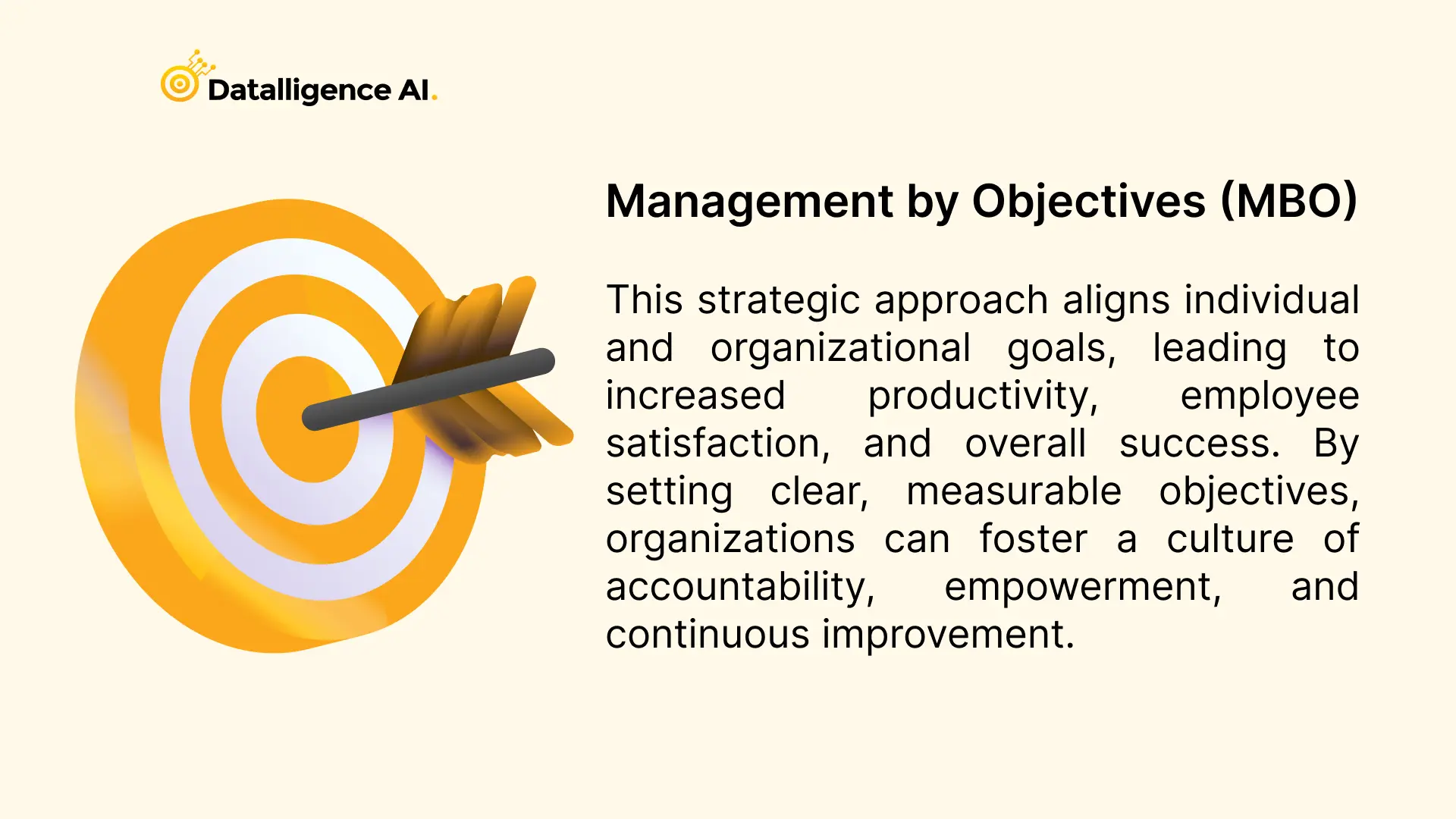
MBO Overview
Management by Objectives (MBO) is a strategic performance appraisal method that has been around for decades. It focuses on aligning individual goals with organizational objectives. In this approach, managers and employees collaborate to set clear, measurable goals that contribute to the company’s overall success. MBO emphasizes transparency, with company goals set by top management and made visible to all employees. This top-down approach ensures that everyone understands the organization’s objectives and has a defined role in achieving them.
MBO Implementation
To implement MBO effectively, organizations typically follow a structured process:
- Define organizational objectives
- Share objectives with employees
- Encourage employee participation in goal-setting
- Monitor progress regularly
- Evaluate performance and reward achievements
This process requires continuous two-way communication between management and employees to track progress and adjust objectives as needed. While implementing MBO can be challenging and time-consuming, it often results in improved organizational structure and more efficient utilization of human resources.
MBO Benefits
MBO offers several advantages for organizations:
- Enhanced communication between management and employees
- Improved performance through clear, measurable objectives
- Better alignment of individual talents with tasks
- Increased employee involvement and commitment
- More objective performance evaluation based on quantifiable goals
360-Degree Feedback
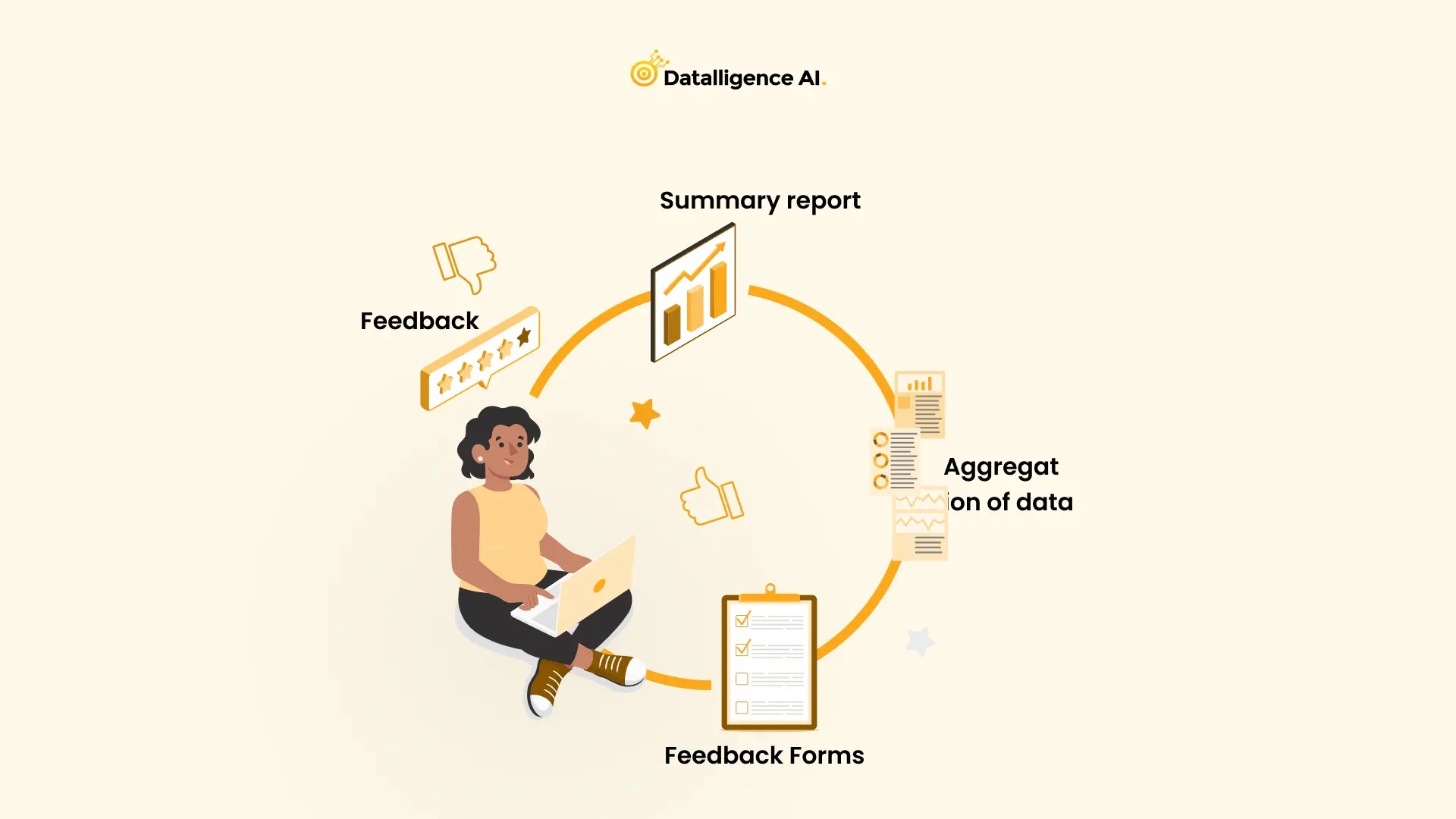
360-Degree Feedback Explained
The 360-degree feedback method is a comprehensive performance appraisal approach that gathers input from multiple sources in an employee’s professional circle. This includes feedback from managers, peers, subordinates, and sometimes even customers or vendors. Unlike traditional reviews that rely solely on a manager’s assessment, this method provides a more holistic view of an employee’s competencies and job performance.
360-Degree Feedback Process
The process typically involves the following steps:
- Selection of reviewers who have worked with the employee for at least six months
- Distribution of anonymous online feedback forms
- Collection and aggregation of data
- Generation of a summary report
- Review of feedback with the employee
It’s crucial to note that 360-degree feedback should be used as a development tool, not for performance evaluation or determining pay and promotions.
360-Degree Feedback Advantages
This method offers several benefits:
- Increased self-awareness among employees
- A balanced view of organizational expectations
- Identification of strengths and weaknesses in employee skill sets
- Promotion of a feedback culture with open communication
- Support for succession planning
- Identification of training opportunities
Behaviorally Anchored Rating Scales (BARS)
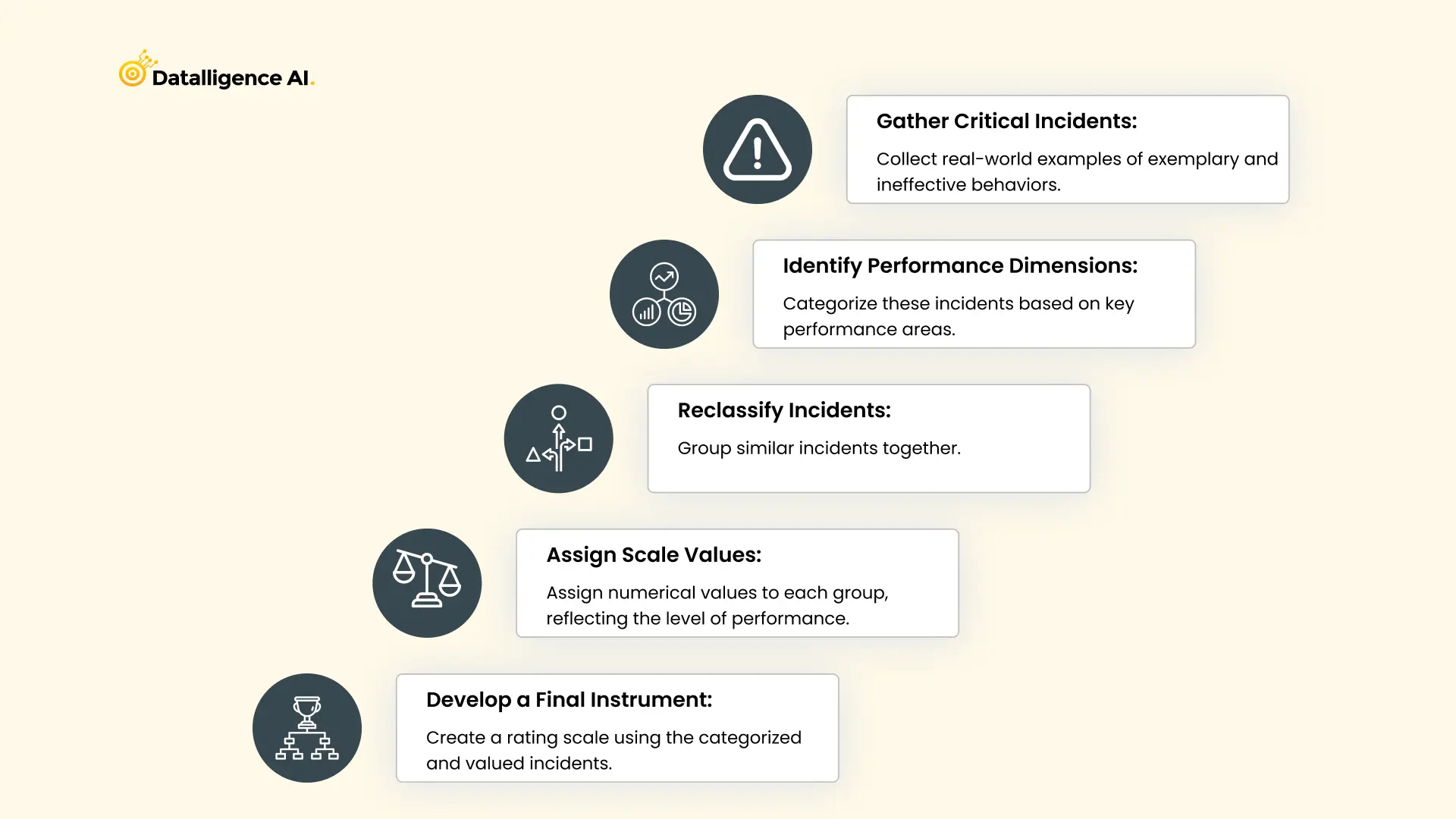
BARS is a performance appraisal method that combines traditional rating scales with specific behavioral examples. This approach focuses on observable behaviors rather than personal traits, providing a more objective and structured evaluation process.
BARS Methodology
The BARS methodology involves defining performance dimensions and developing descriptions for each level based on specific, observable behaviors. These descriptions are then anchored to points on a rating scale, typically ranging from poor to excellent. Evaluators rate employees by selecting the behavior that best matches their observed performance.
BARS Implementation
Implementing BARS requires several steps:
- Identify critical behaviors through job analysis and expert interviews
- Develop performance dimensions relevant to the role
- Generate behavioral anchors for each dimension
- Conduct a validation study to ensure accuracy
- Train raters on using the scale effectively
- Integrate BARS into the performance management system
This process demands significant time and effort but results in a comprehensive system aligning roles with business priorities.
BARS Effectiveness
BARS has proven to be an effective performance appraisal method for several reasons:
- Objectivity: The use of predefined criteria and behavioral descriptions reduces personal biases
- Clarity: Employees gain a clear understanding of performance expectations
- Detailed feedback: Managers can provide specific, behavior-based feedback
- Flexibility: BARS can be adapted to various job roles and criteria
- Alignment: It links employee performance directly to organizational goals
- Validity: The use of observable behaviors enhances the reliability of evaluations
Objective and Key Results (OKRs)
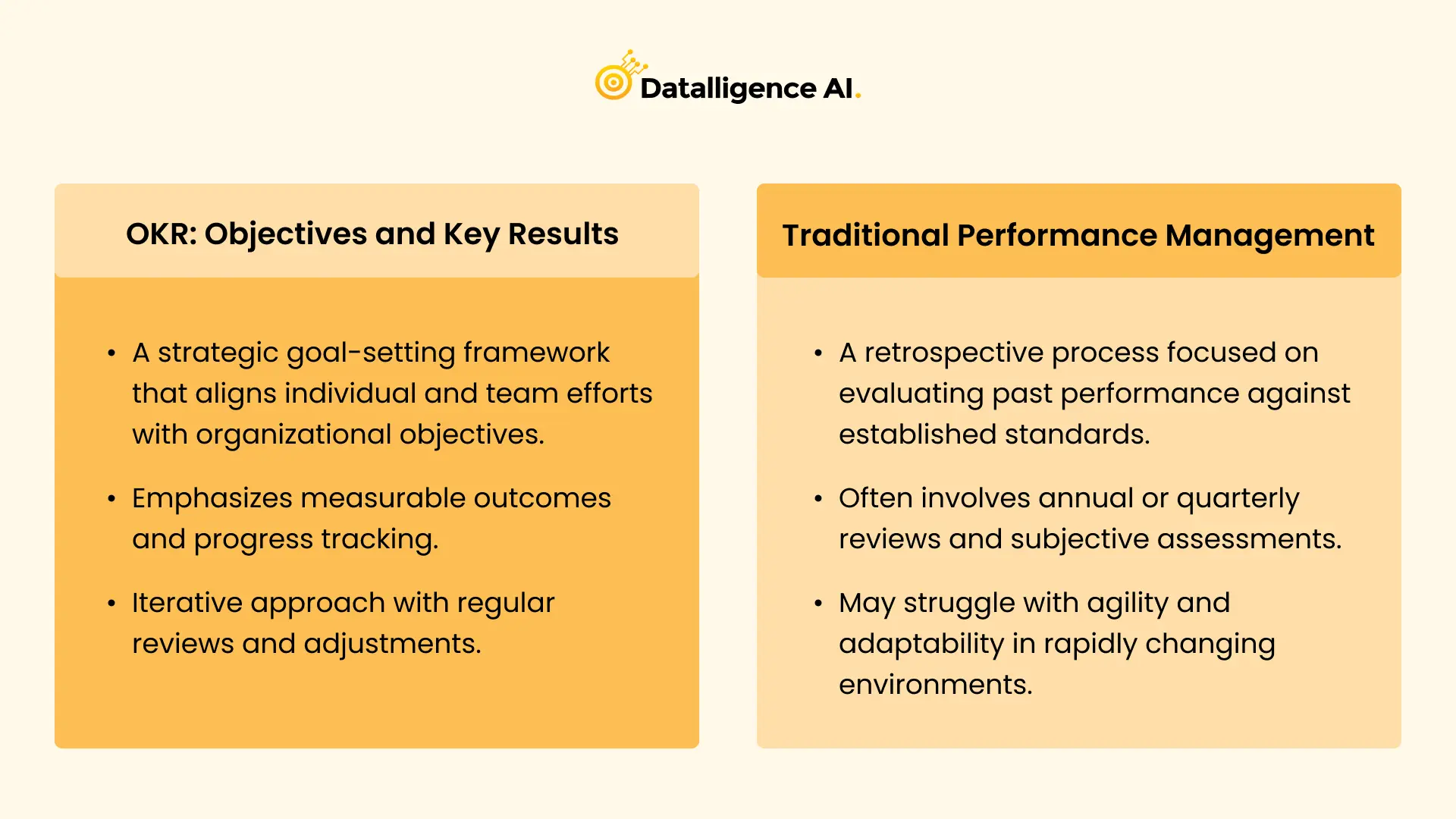
OKRs, or Objectives and Key Results, represent a goal-setting framework designed to align team efforts with organizational objectives. This method focuses on setting ambitious stretch goals that encourage innovation and growth. Unlike traditional performance management systems, OKRs emphasize the process of achievement rather than specific targets.
OKRs Explained
The OKR model consists of two main components:
- Objectives: Qualitative descriptions of what an organization aims to accomplish.
- Key Results: Measurable metrics that gage progress toward objectives.
OKRs promote transparency, collaboration, and alignment with broader organizational goals. They are typically set for shorter cycles, often quarterly, to encourage adaptability and timely course corrections.
OKRs vs MBO
While both OKRs and Management by Objectives (MBO) aim to set and communicate business objectives, they differ in several key aspects:
- Risk Approach: OKRs embrace a “dare to fail” attitude, favoring innovation, while MBOs tend to be more risk-averse.
- Focus: OKRs connect the “what” and “how” of goal achievement, whereas MBOs primarily focus on the “what.”
- Transparency: OKRs are public and visible to everyone in the organization, while MBO goals are often private.
- Review Cycle: OKRs typically follow quarterly cycles, allowing for more frequent adjustments compared to MBO’s annual reviews.
OKRs Best Practices
To implement OKRs effectively:
- Set ambitious yet achievable objectives
- Ensure key results are quantifiable and outcome-focused
- Limit the number of OKRs to maintain focus
- Encourage bottom-up goal-setting to boost motivation
- Regularly review progress and adjust as needed
- Avoid tying OKRs directly to performance reviews or compensation
Critical Incident Method
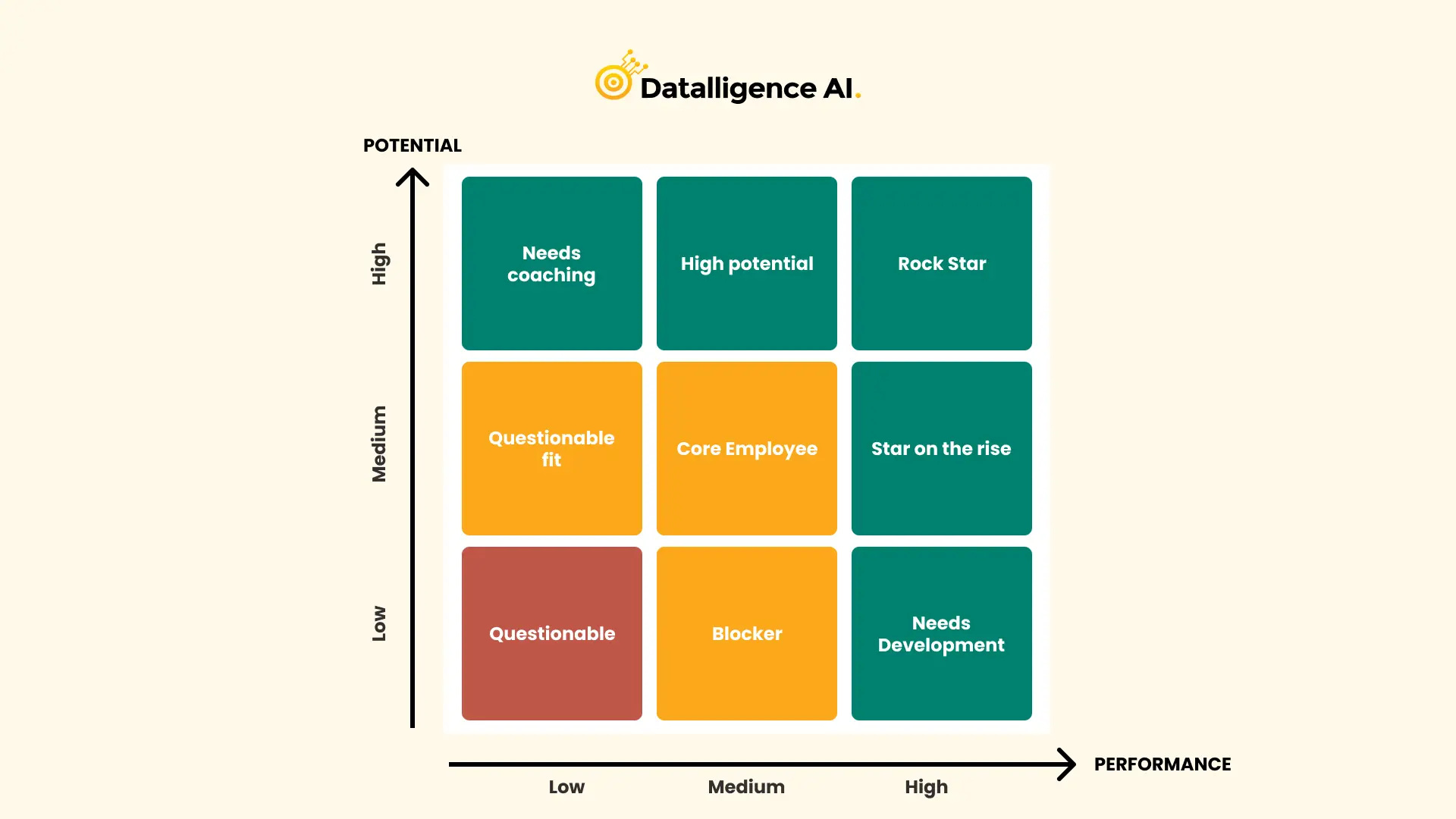
Critical Incident Method Overview
The Critical Incident Method is a qualitative performance appraisal technique that focuses on identifying and describing specific events where an employee demonstrated exceptionally good or poor behavior related to their job tasks. This method tracks instances when employees either exceed expectations or fall significantly short of their job function mandate. It measures both employee output and the behavior linked to performance metrics, providing concrete examples that have a significant impact on individual and organizational performance.
Critical Incident Method Process
The process involves several key steps:
- Managers observe and record specific incidents of employee behavior.
- These incidents are documented in an “incident’s net” for later analysis.
- Behaviors are categorized to manage the potentially vast number of narratives.
- The collected data is analyzed to make decisions about remuneration, training, and team growth.
It’s crucial that incidents are recorded as they occur to maintain accuracy and detail. Some organizations encourage employees to record their own critical incidents, fostering self-reflection and responsibility.
Critical Incident Method Benefits
This method offers several advantages:
- Provides detailed, specific feedback for employee improvement
- Highlights different employee strengths and weaknesses effectively
- Facilitates targeted development efforts
- Allows for measurement across categories and employees simultaneously
- Emphasizes behaviors that significantly impact organizational success
Assessment Center Method
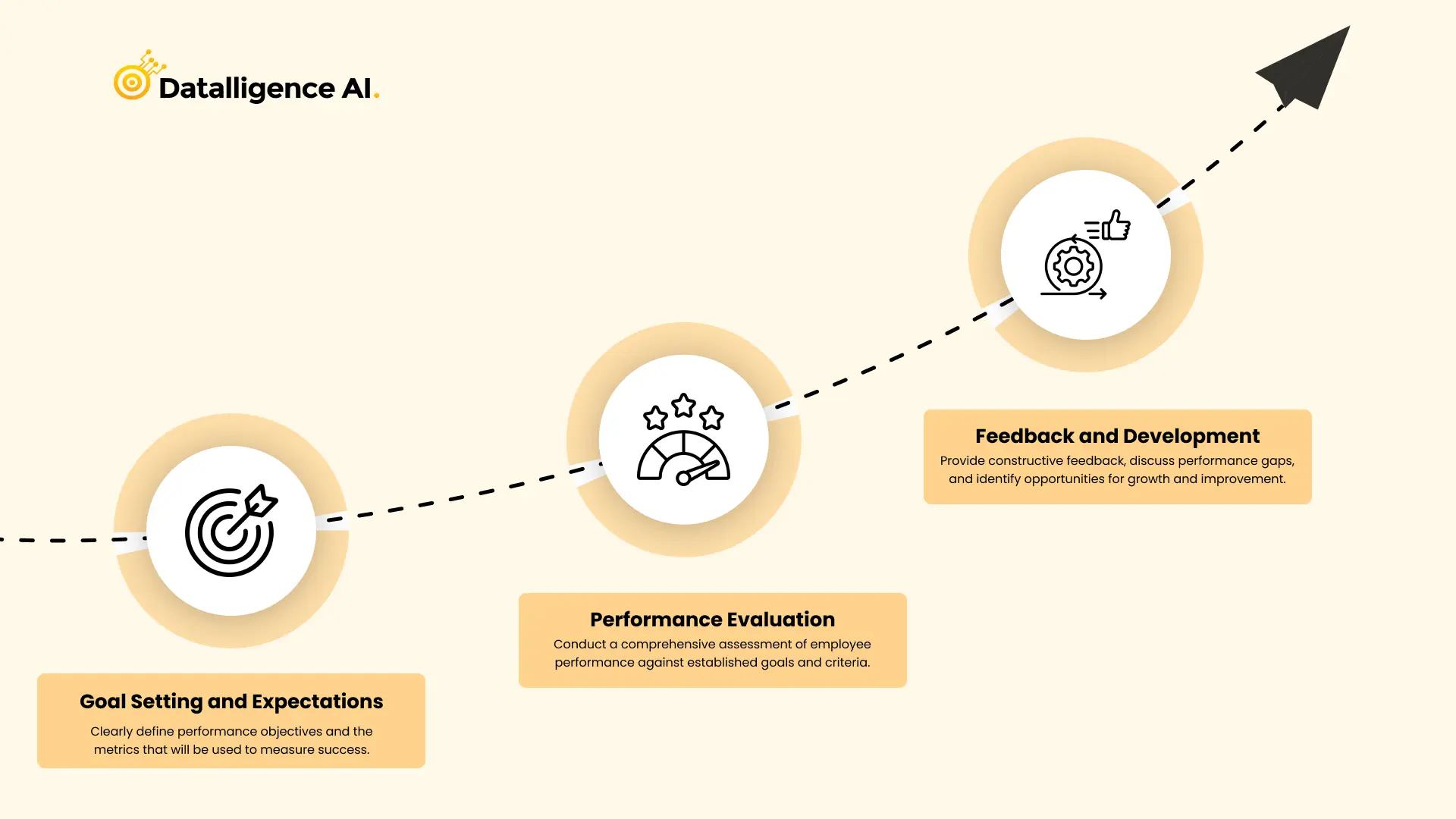
The Assessment Center Method is a comprehensive evaluation process used to assess candidates’ suitability for specific job roles, particularly for senior management positions. This approach involves a series of exercises and activities designed to simulate real-world job scenarios, allowing employers to evaluate candidates’ competencies and potential performance.
Assessment Center Approach
Assessment centers typically last one or more days and involve multiple candidates participating in various tasks. The process includes standardized evaluations based on multiple inputs, with several trained observers using different techniques to assess candidates. Judgments about behavior are made primarily through specifically developed assessment simulations, which are then pooled or statistically integrated to provide a comprehensive evaluation.
Assessment Center Activities
Common activities in assessment centers include:
- In-basket exercises: Candidates deal with tasks typical of the job role.
- Case analyzes: Participants read and prepare written reports on job-related problems.
- Leaderless group discussions: Groups of 5-7 individuals work together to solve problems.
- Role-plays: Candidates interact with others as they would in the job.
These activities are designed to evaluate critical competencies such as communication, conflict management, leadership, and critical thinking.
Assessment Center Advantages
Assessment centers offer several benefits:
- Comprehensive evaluation of candidates’ skills and competencies
- Objective assessment through standardized criteria
- Opportunity for professional development through feedback
- Ability to evaluate multiple candidates simultaneously
- Simulation of real-world job scenarios
- Identification of the best-suited candidates for specific roles
Self-Assessment Method

The self-assessment method is a crucial component of the performance management process, offering employees an opportunity for self-reflection on their job performance. This approach allows individuals to evaluate their strengths, areas for improvement, and contributions to the organization.
Self-Assessment Process
The self-assessment process typically involves employees completing a standardized form or template provided by their manager or HR team. These forms often include questions about accomplishments, learning opportunities, goals, and feedback on workplace culture. Employees are asked to rate their performance on a numerical scale, answer open-ended questions, or list their strengths and weaknesses. Once completed, the form is submitted to the manager for review before a performance discussion meeting.
Self-Assessment Benefits
Self-assessments offer several advantages:
- Improved data insights: Employees gain a management perspective on their performance by analyzing project data.
- Enhanced communication: It helps managers understand the day-to-day responsibilities of their team members.
- Employee empowerment: Self-assessments give employees a voice in their performance evaluation.
- Goal setting: It aids in setting clearer objectives and identifying areas for professional development.
Self-Assessment Limitations
Despite its benefits, the self-assessment method has some challenges:
- Difficulty in self-reflection: Employees may struggle to assess their own performance objectively.
- Bias: It’s challenging to eliminate personal bias in self-evaluations.
- Discomfort: Some employees may feel uncomfortable highlighting their achievements or weaknesses.
Checklist Method

The Checklist Method is a structured approach to performance appraisal that uses predetermined criteria to evaluate employee performance. This method involves creating a comprehensive list of tasks, behaviors, and competencies relevant to a specific job role.
Checklist Method Explained
In this approach, managers use a standardized form or template to assess an employee’s performance across various dimensions. The checklist typically includes a series of questions or statements about job-related behaviors and skills. Managers rate each item based on the employee’s performance, often using a simple “yes” or “no” format or a numerical scale.
Checklist Method Implementation
To implement the Checklist Method effectively:
- Develop a detailed checklist tailored to each job role
- Include specific, observable behaviors and competencies
- Train managers on using the checklist consistently
- Conduct regular performance reviews using the checklist
- Encourage employees to use self-assessment checklists
Checklist Method Advantages
The Checklist Method offers several benefits:
- Consistency in evaluation across employees
- Reduced bias through standardized criteria
- Comprehensive coverage of job-related skills and behaviors
- Easy to administer and analyze
- Provides clear performance expectations for employees
Peer Review Method
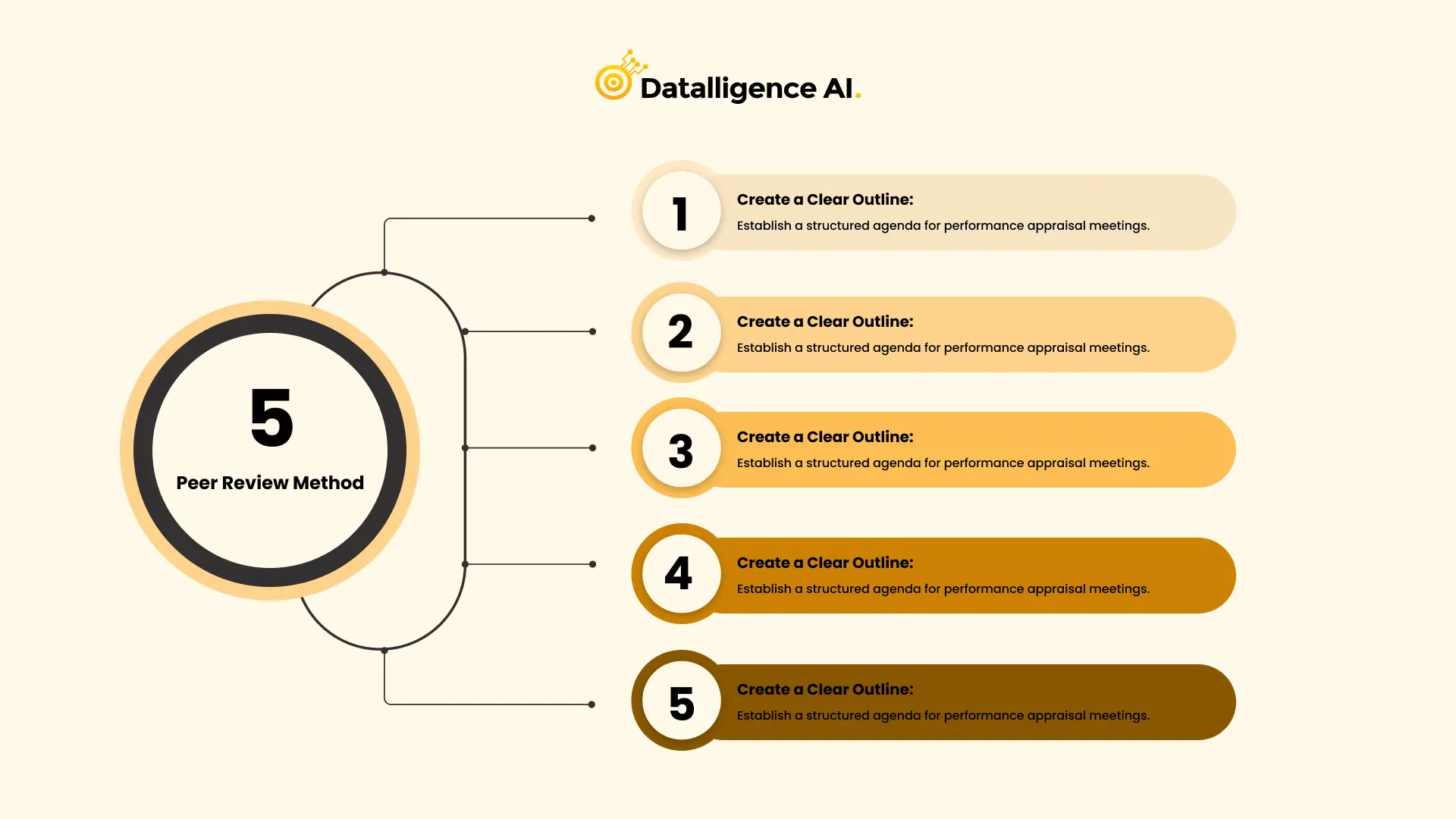
The peer review method is a collaborative approach to performance appraisal where employees evaluate their colleagues’ work performance, skills, and competencies. This method provides a multidimensional view of an employee’s contributions, offering insights that managerial assessments might miss. Organizations typically implement peer reviews as part of a formal evaluation process, allowing managers to gain a more comprehensive understanding of each team member’s strengths and weaknesses.
Peer Review Process
In a typical peer review process, employees anonymously fill out standardized forms about their colleagues’ performance. The anonymity encourages honest feedback, allowing reviewers to express their opinions without fear of repercussions. Reviewers are usually selected from those who regularly interact with the employee being evaluated, ensuring they have a working knowledge of the reviewee’s job duties and required skills.
Peer Review Benefits
Peer reviews offer several advantages to organizations:
- Enhanced communication between team members
- Identification of hidden talent and quiet performers
- Improved data insights for management
- Employee empowerment through participation in the evaluation process
- More objective assessment of performance
These benefits contribute to a more engaged workforce and can help in developing targeted training programs to address specific skill gaps.
Peer Review Challenges
Despite its benefits, the peer review method has some potential drawbacks:
- Subjectivity and bias due to personal relationships
- Inconsistent feedback quality among reviewers
- Time-consuming process that may impact productivity
- Reluctance to provide honest feedback due to fear of straining work relationships
- Concerns about confidentiality, even in anonymous systems
To mitigate these challenges, organizations should provide clear guidelines, emphasize the importance of objectivity, and ensure a supportive environment for the peer review process.
Psychological Appraisal
Psychological appraisal is a performance evaluation method that focuses on assessing an employee’s future potential rather than past performance. This approach analyzes seven key components: interpersonal skills, cognitive abilities, intellectual traits, leadership skills, personality traits, emotional quotient, and other related skills. Qualified psychologists conduct various tests, including in-depth interviews, psychological assessments, and discussions, to evaluate employees effectively.
Psychological Appraisal Approach
The psychological appraisal method involves analyzing specific scenarios to gage an employee’s capabilities. For instance, observing how an employee handles an aggressive customer can provide insights into their persuasion skills, behavioral responses, and emotional intelligence. This approach helps determine hidden potential and future performance.
Psychological Appraisal Tools
Several tools are used in psychological appraisals:
- Myers-Briggs Type Indicator: Determines personality types based on extraversion/introversion, sensing/intuition, thinking/feeling, and judging/perceiving groupings.
- Caliper Profile: Gages how an applicant’s traits fit within the context of the role.
- SHL Occupational Personality Questionnaire (OPQ32): Assesses how an individual’s emotions, thinking style, and interpersonal relationships may impact their work.
- Eysenck Personality Inventory: Evaluates a prospective employee’s personality by determining their extroversion level, neuroticism level, and honesty.
Psychological Appraisal Benefits
Psychological appraisals offer several advantages:
- Extract measurable, objective data about an employee’s performance and potential.
- Can be deployed easily compared to other performance appraisal methods.
- Provide introverted or shy employees a platform to showcase their potential.
- Offer insights into employees’ motivations and behaviors, helping identify strengths and weaknesses.
This method is ideal for large enterprises seeking to develop leadership pipelines, build teams, and resolve conflicts. Companies like Ford Motors, Exxon Mobil, and Procter & Gamble use psychological appraisals to assess their employees’ personality and performance.
11. Human Resource Accounting Method
Human Resource Accounting (HRA) is a performance appraisal method that quantifies and reports the value of human resources in financial terms. This approach recognizes employees as organizational assets and focuses on the return on investment (ROI) in human capital. HRA helps companies identify, measure, and report investments made in human resources, assessing their impact on organizational performance.
HR Accounting Method Explained
HRA analyzes an employee’s performance through the monetary benefits they yield to the company. It compares the cost of retaining an employee (cost to company) with the monetary contributions the organization has ascertained from that specific employee. This method considers various factors, including recruitment costs, training and development expenses, employee compensation and benefits, and productivity analysis.
HR Accounting Implementation
To implement HRA effectively, organizations typically follow these steps:
- Identify the gap between market rates and current employee packages
- Determine the monetary and non-monetary value an employee brings to the table
- List employee achievements during the review period (e.g., increase in subscriber count, revenue improvement, new deals won)
- Track expenses related to attracting, selecting, and hiring new employees
- Measure investments in employee training programs and professional development
- Analyze the total cost of employee compensation packages
- Evaluate employee performance through various metrics and key performance indicators (KPIs)
HR Accounting Advantages
HRA offers several benefits to organizations:
- Enhances decision-making processes by providing insights into workforce value
- Helps identify financial implications of employee performance on the organization’s bottom line
- Assists in determining training and development needs
- Aids in effective resource allocation
- Provides a basis for performance-based incentives and rewards
- Improves strategic planning and employee management
Conclusion
The evolution of performance appraisal methods has a significant impact on organizational success and employee growth. From traditional approaches like Management by Objectives to modern techniques such as OKRs, these methods provide structured frameworks to track performance and align individual goals with company objectives. Each method offers unique benefits, addressing different aspects of performance evaluation and employee development. As organizations continue to adapt to changing work environments, the effective implementation of these appraisal methods becomes crucial to foster a culture of continuous improvement and productivity.
At Datalligence, we understand the importance of choosing the right performance appraisal method for your organization. Our expertise in data-driven solutions can help you implement and optimize these methods to achieve your business goals. To explore how our tailored approach can enhance your performance tracking and employee development processes, start your free trial today. By leveraging the right combination of performance appraisal method, companies can create a more engaged workforce, develop strong leaders, and align their culture with strategic objectives, ultimately driving long-term success.
Frequently Asked Questions
1. What is a performance appraisal?
A performance appraisal is a systematic evaluation of an employee’s performance over a specific period. It aims to assess productivity, skills, accomplishments, and areas for improvement, ultimately helping organizations make decisions on promotions, training, and development.
2. Why are performance appraisals important?
Performance appraisals provide valuable insights into employee contributions, help align individual goals with organizational objectives, foster employee development, and support decisions related to promotions, compensation, and workforce management.
3. How can I write an effective performance review?
An effective performance review should be objective, data-driven, and aligned with the company’s strategic goals. Focus on clear, measurable outcomes, and offer constructive feedback that encourages growth. Modern performance reviews often rely on real-time data from automated systems, which help ensure that feedback is timely and actionable.
- Which performance appraisal method is most effective?
There isn’t a one-size-fits-all solution for performance appraisals. The best method depends on your company’s unique needs, culture, and goals. It’s important to adopt an appraisal system that streamlines processes, facilitates continuous feedback, and aligns with your company’s long-term performance management strategy.
5. What are the key differences between traditional and modern performance appraisal methods?
Traditional performance appraisal methods usually involve formal, once-a-year reviews between managers and employees, focusing primarily on past performance. In contrast, modern approaches emphasize ongoing feedback, real-time insights, and involve input from multiple stakeholders, including peers and even self-assessments. Technology often plays a key role in modern systems, making them more dynamic and engaging for employees.












